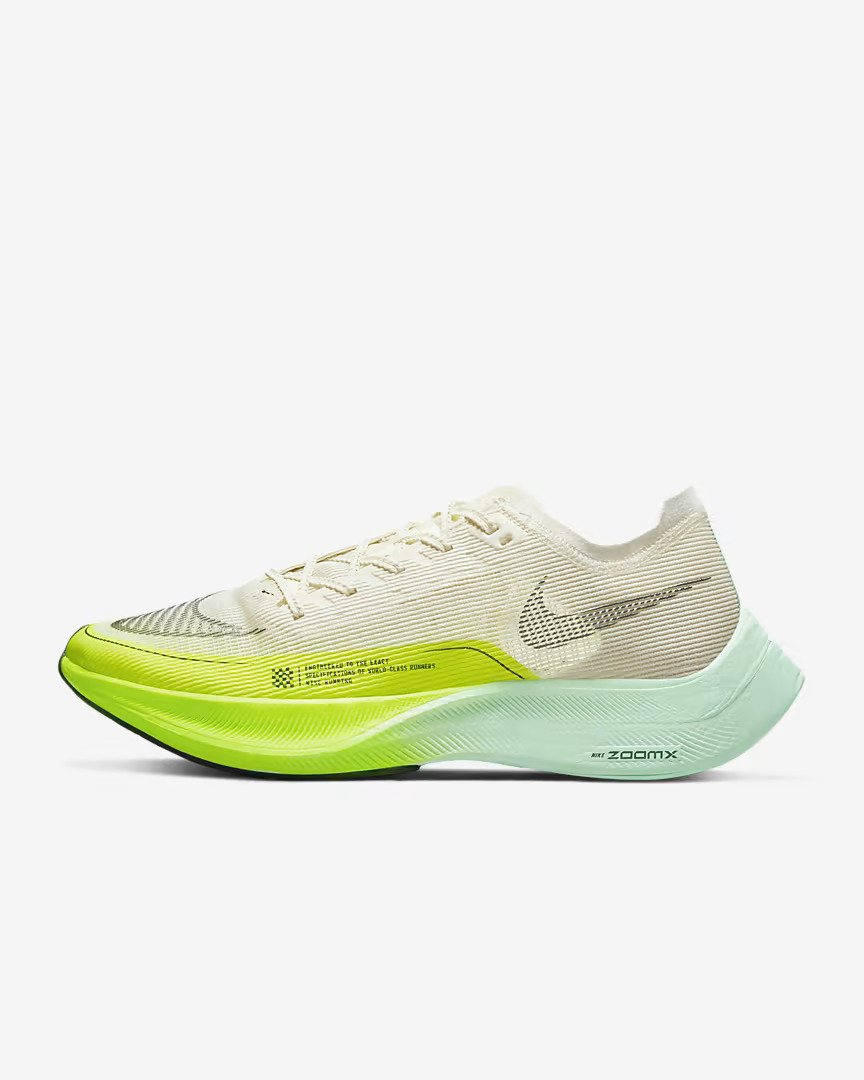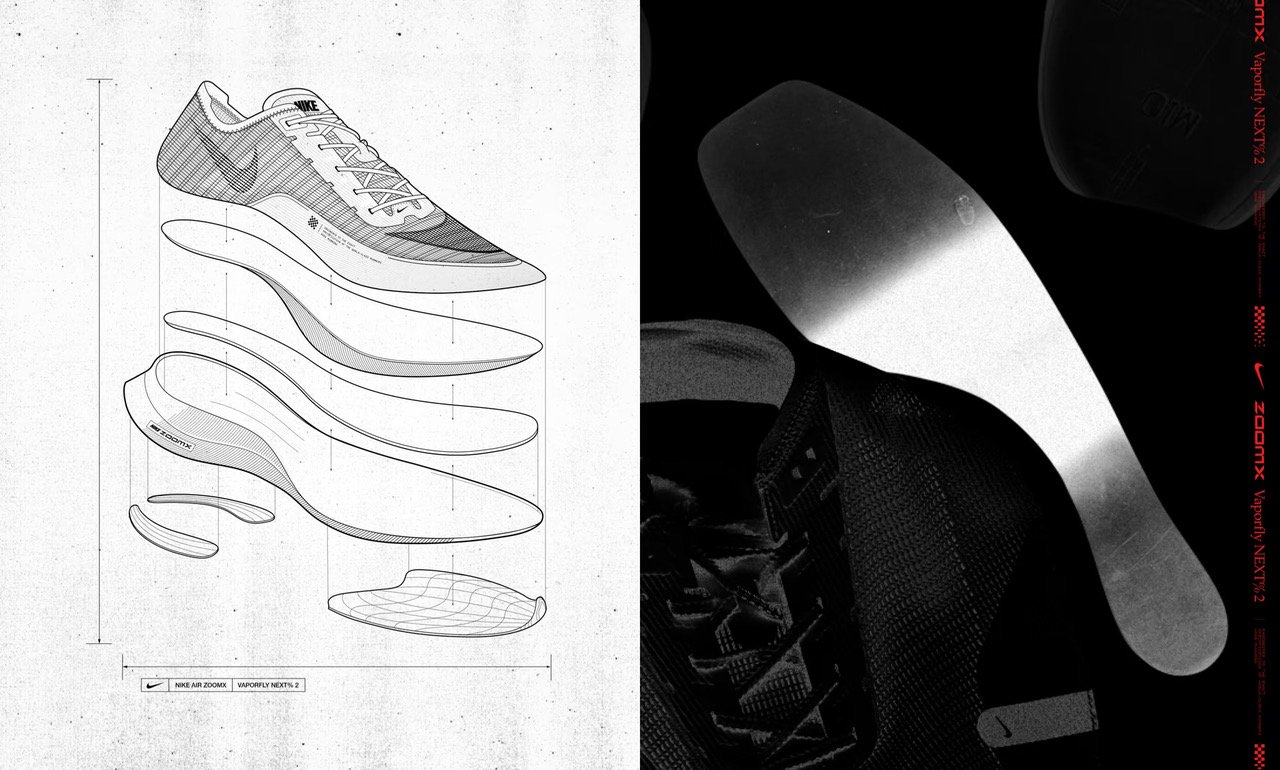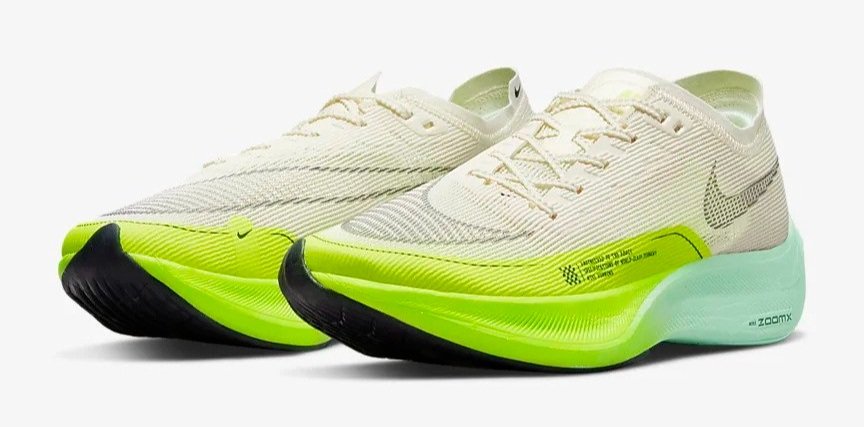Good Design: Nike ZoomX Vaporfly NEXT% 2
Nike: a familiar name in both fashion and elite athletics. The company was founded in 1964 by Bill Bowerman, a track and field coach at the University of Oregon, in conjunction with a former student named Phil Knight. At the start, the company was focused on designing high-performance running shoes; however, it allowed its scope to increase as it dove headfirst into basketball, golf, and tennis with endorsements by athletes such as Michael Jordan, Mia Hamm, Roger Federer, and Tiger Woods [1]. Now, Nike has products and gear for sports of all types and kinds. Based on recent shoe releases, Nike has returned to its roots by providing exceptional performance, comfort, durability, and even fashion to elite and non-elite runners alike. Through my own experience and research, I can verify that Nike encapsulates this new vision in its Zoom Vaporfly NEXT% 2 shoe design.
Performance
Fig. 1 - The graphic on the right shows the silhouette of the carbon plate which provides springy energy return in the Nike Zoom Vaporfly NEXT% 2. The right side shows an exploded view with (in this order from the top) upper mesh and lacing, upper foam, carbon plate midsole, lower foam, and rubber grip foot-pads [2].
For a while, one of the most significant factors that large running shoe companies wrestled with was making feather-weight shoes without compromising durability, stability, and cushioning. It was a simple equation. The lighter the running shoe, the less weight carried on while running, and the faster runners could run. Not too complicated, right? Nike wanted more, though. Researchers, designers, and developers started asking, “What if we could make light shoes that also improve running efficiency?” The answer to their question was to be found in a common-place material found in all kinds of modern technology: carbon fiber. With amazing fatigue tolerance, a high modulus of elasticity, and low density, it was a shoe-in (pun intended) for Nike’s new 10K - Marathon racing shoes, the Zoom Vaporfly NEXT% 2.
This shoe includes a carbon-fiber midsole plate shown as the third layer from the top in Fig. 1. This plate acts like a spring and is the cause of the purported 4% increased running economy [3]. (Note: Running economy is the measure of oxygen consumption or energy use at a given speed). Research shows that running economy improvements caused by the shoe tend to be closer to 2.6% on average [4]. For marathoners, this is a massive step forward. Most professional marathoners run marathons in around 120-130 minutes for men and 140-150 for women. Factor in the 2.6% economy improvement, and these athletes are shaving off anywhere from about 4-4.5 minutes off: the difference between 15th place and 1st place in some larger marathons. The carbon plate is the most physically apparent performance-improving design.
It should also be noted that a more compliant, more resilient, and lighter midsole foam, a thermoplastic polymer called Pebax, also contributed significantly to the shoe’s performance. Traditionally, most other running shoes contain ethylene-vinyl acetate or thermoplastic polyurethane foams, but these are much heavier and provide lower energy returns [5]. Pebax foam is not only comfortable to wear underfoot, but it’s lightweight and has been reported to improve running economy by itself because of its spring-like qualities.
Comfort
Fig. 2 - Image displays top view emphasizing lacing features, shoe heel design, and overall shape [2].
Another source of careful consideration in the design of the shoe is comfort. In addition to the foam providing a smooth ride, these shoes have many comfort features incorporated into the design.
One such feature, the upper, is made of a lightweight woven breathable mesh to prevent the sweaty, cramped feeling that some uppers in other shoes provide. The upper also includes rubber-like supports by the outsides of the toes to help guarantee a locked-in feel.
In addition, the tongue is designed to be asymmetrical so the upper material doesn’t bunch up when tying the laces tight, and the shoe gets a snugger fit. Nike didn’t stop there with the tongue, though. The tongue is cut into a V-shape so that the tongue parts over the lower ankle, preventing blisters from occurring.
Lastly, midway up the inside of the shoe, by the back of the heel, is a foam pad. This pad provides a buffer between the back of the heel and the coarser heel fabric for further blister mitigation and prevention.
Through and through, this shoe has the features needed to provide not just a fast feel, but also a pampered ride during your race towards a new personal best.
Durability
With so many incredible features, I wanted to verify that the durability was as exceptional as the features of the shoe. Unsurprisingly, there are several design features that match the vaporfly’s durability with performance. The most outstanding is the rubber pads on the bottom. The central, black rubber pad extending from the start of the forefoot up past the tip of the shoe provides a more durable protection to cover the foam body while also preventing damage to the upper at the front end of the shoe during stride follow-through. Hidden at the heel of the foam are two inset rubber pads that provide additional protection to the less durable foam in the case of heel striking.
The upper also sports some impressive durability despite a dainty appearance. The woven mesh is deceptively resistant to wear and tear, and the rubber-like rim by the toe also prevents friction wear from causing tears in the mesh. Even the top-most eyelets sport small plastic reinforcements to prevent the eyelets from tearing as a runner laces up for their race.
While there were many different opinions about how long the shoes last, the general consensus was that they will last for about 250 miles as a racing shoe and a number of miles afterwards for speed workouts [5]. This is incredible considering that most standard training shoes will last for about 300-500 miles.
Fashion
Fig. 3 - Image displays angled side view emphasizing decal design, contours, and overall side body shape [2].
If you plan on running fast, you might as well look fast. Thankfully this shoe can help you do both. In addition to its speedy features, the Vaporfly NEXT% 2 has a sleek body and aerodynamic design. Nike went a step further, though. Main logos were designed to enhance this look, the swoosh lines tracking parallel to the curves of the shoe. On the outside of the mesh, Nike has also printed a small racing flag pattern next to the words “Engineered to the exact specifications of world-class runners.” As a cherry on top, shoes can be purchased in all imaginable combinations of neon and a few more subtle color combinations. In an overall review, the visual design screams speed.
My Experience
I first purchased and ran in these shoes about 4 months ago. Even after trying them on to see how well they fit, I could already tell that they were going to be fast. They were springy, comfortable, and incredibly light. Even walking in them was an experience. The best way I can describe the experience, I felt as if they were pushing me forward with every step.
Because I wanted to see how much of a difference they made in my pacing and muscle fatigue first-hand, my trial run was a 15 mile long run on a treadmill (so I could record paces and get a longer trial period). At that point in my training, I was running most of my long runs at about a 7 minute average mile pace. This time, I ran a 6:40 average pace (almost a 5% difference) and felt amazing. My muscles felt less sore and I recovered quicker than usual. No doubt, there were other factors which must have contributed to me running faster than predicted by research, but after running in the Vaporfly shoes, I can say without a doubt that I ran faster, was more comfortable, and recovered more quickly than in any other pair of racing shoes or flats I have ever worn.
To put them to the ultimate test, though, I needed to run a marathon in them. On Jan 28th of this year, at the Sun Marathon in St. George, I ran my fastest marathon yet by over 10 minutes. This marathon included both downhills and uphills throughout and these shoes performed incredibly on both. After the race, I checked the wear and tear on them, and it was apparent that they had held up very well during the race, and still had capacity for many more.
Conclusion
The Nike Zoom Vaporfly - coming in at only 6.6 ounces and a whopping $250 retail - is chalk full of innovative new functional elements.. What makes this design so noteworthy is the fact that Nike found a way to provide comfort, style, and durability while also providing exceptional performance. In the wake of the release of this shoe, many other running shoe companies have attempted to release similar models with only marginal results. True to their claim, Nike has “engineered [the Vaporfly NEXT% 2 shoes] to the exact specifications of world-class runners.”
References
[1] Britannica, T. Editors of Encyclopaedia (2022, December 1). Nike, Inc.. Encyclopedia Britannica. https://www.britannica.com/topic/Nike-Inc
[2] Nike. (n.d.). Vaporfly 2: Men's Road Racing Shoes. Retrieved April 13, 2023, from https://www.nike.com/id/t/vaporfly-2-road-racing-shoes-D4ntS0/CU4111-103
[3] Patoz, A., Lussiana, T., Breine, B., & Gindre, C. (2022). The Nike Vaporfly 4%: a game changer to improve performance without biomechanical explanation yet. Footwear Science, 14(3), 147–150. https://doi.org/10.1080/19424280.2022.2077844
[4] Barnes, K. R., & Kilding, A. E. (2019). A Randomized Crossover Study Investigating the Running Economy of Highly-Trained Male and Female Distance Runners in Marathon Racing Shoes versus Track Spikes. Sports Medicine, 49(2), 331–342. https://doi.org/10.1007/s40279-018-1012-3
[5] Dustin P. Joubert & Garrett P. Jones (2022) A comparison of running economy across seven highly cushioned racing shoes with carbon-fibre plates, Footwear Science, 14:2, 71-83, DOI: 10.1080/19424280.2022.2038691
[6] Marathon Handbook. (n.d.). Nike ZoomX Vaporfly Next% 2 Review. Retrieved April 13, 2023, from https://marathonhandbook.com/nike-zoomx-vaporfly-next-2-review/#:~:text=I%20would%20say%20this%20shoe,is%20~200%2D250%20miles.
To cite this article:
Godfrey, William. “Good Design: Nike ZoomX Vaporfly NEXT% 2.” The BYU Design Review, 17 Apr. 2023, https://www.designreview.byu.edu/collections/good-design-nike-zoomx-vaporfly-next-2.









